In “Cardinal Canvas,” Adam Golomb spotlights art on and around the University, exploring and reviewing artwork that students may otherwise miss.
Editor’s Note: This article is a review and includes subjective thoughts, opinions and critiques.
At the end of the Earth, there is white: piercing and all-encompassing. Yet deep in Antarctica, fighting against a perpetual snowstorm, are 99 fiberglass blue spheres. These spheres, hand-placed by artist Lita Albuquerque, are the subject of the Anderson Collection’s newest exhibit “Stellar Axis.”
In 2006, Albuquerque and her team ventured into Antarctica to place each of these spheres under one of the 99 stars in the Antarctic sky. The result: a sea of spread-out blue spheres, harsh against the overwhelming white that dominates this ice kingdom.
The first floor of the Anderson houses a multimedia encapsulation of Albuquerque’s original work of land art. The exhibit houses one of the original spheres, a video depicting the spheres in their original environment and a few inkjet-printed close-ups, including images of some of the spheres and the Antarctic from satellite footage.
The symbolism of the spheres themselves is intentionally ambiguous. Initially, I understood them to be drops of water, representative of the evolution between fluid water and the frozen-over ice that defines the South Pole.
Obviously, the Anderson cannot provide viewers with the true experience of witnessing “Stellar Axis” in the South Pole. However, the video projected on the main wall of the exhibit communicated the feeling of helplessness of the original display. These spheres are not small by any means – easily five feet in diameter – but they are barely visible in the context of the Antarctic wind.
When they are discernible, however, the intense cobalt blue absorbs all of the Sun’s rays, making it shine against the ice, as if draining its life force. I was amazed watching this phenomenon in the video; the landscape is so barren and white that the blue spheres don’t have to fight anything else to sponge in the natural light. The terrain engulfs them, yet they manage to hold their own, emanating vibrant color while being engulfed.
It was here I concluded the spheres weren’t symbols of water, but emblems of persistence. These spheres were artificially placed in a battle they should never have been capable of winning. Yet, they hold their own, independently, colorfully, beautifully. “Stellar Axis” is inspiring, a reminder that hope is as ubiquitous as the Antarctic ice.
Albuquerque’s work also captures a moment in space and time. She and her team placed the spheres in accordance with the stars above the Antarctic in 2006 but, as the Earth’s axis tilted in the time since, the placement of the spheres has strayed from their respective stars. The work is thus dependent on the Earth’s natural characteristics, a common aspect of land art.
Due to the Earth’s tilt, tracking one star over time begins to form a spiral path, which is depicted at the exhibit in a satellite print of Earth centered around the South Pole. Albuquerque’s piece loses its astronomical accuracy immediately, but it is nonetheless an intentional decision to realize a specific moment. “Stellar Axis” embraces the ephemerality of the Earth’s movement.
This artwork thus both discusses persevering against difficulty and the ability to accept and find beauty in inevitable change. Albuquerque opts to portray the nuance behind our relationships with natural processes; I find its complexity inspiring.
Feel the harsh Antarctic snowstorms and the Earth’s tilt for yourself while “Stellar Axis” is on display at the Anderson until Aug. 18.
